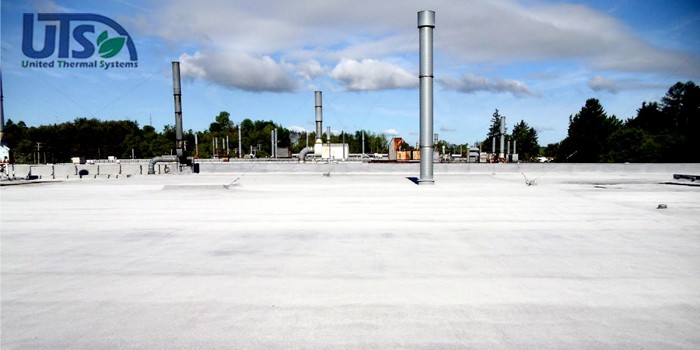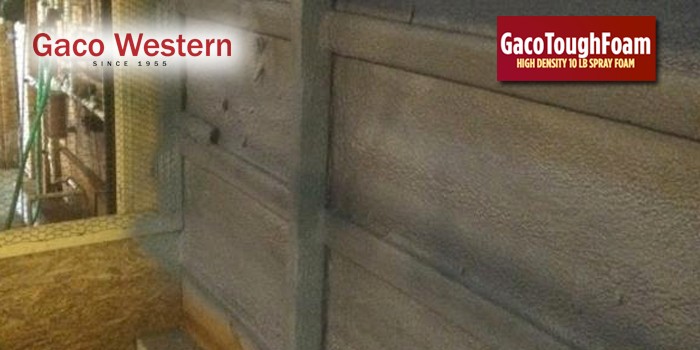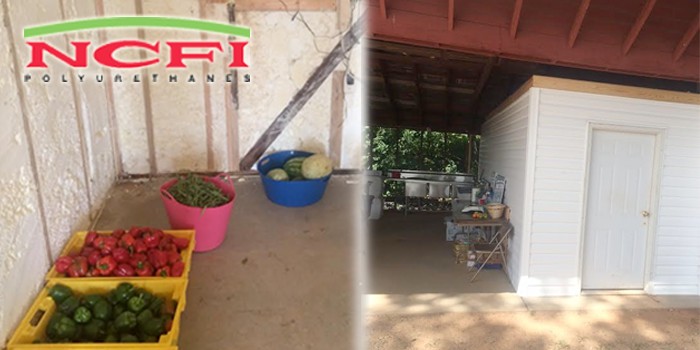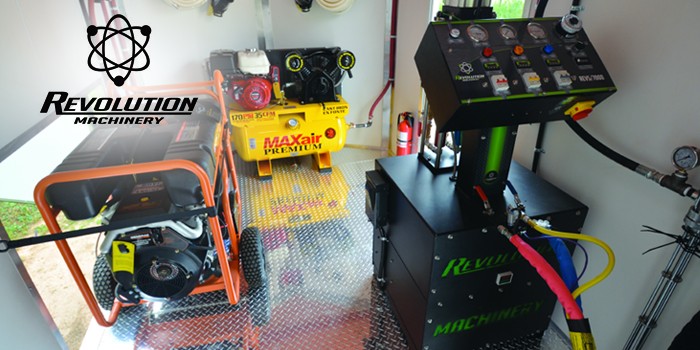Hurricane Season is Already Upon Us - Closed Cell Spray Foam to the Rescue
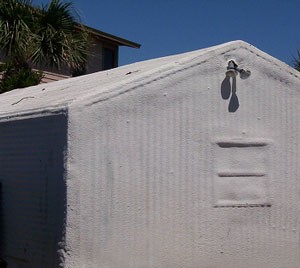
August 2008 - Reston, VA – The word “Epiphany” is defined by Merriam/Webster Online Dictionary as, “an intuitive grasp of reality through something (as an event) usually simple and striking”
Closed Cell Spray Polyurethane Foam, (ccSPF) is well known for its insulation value, air barrier characteristics and moisture control features, but, not many designers take advantage of the structural enhancing properties of the foam.
ccSPF’s unique combination of exceptional adhesive properties, high tensile strength to weight characteristics and flexibility provide the material with a remarkable ability to hold lightweight structures together during strong wind events such as hurricanes.
In the case of the use of ccSPF’s for structural enhancement, my epiphany came in late July 1980.
Storage Shed Survives a Direct Hit from a Category 3 Hurricane
In 1976, I bought a travel trailer and installed it at the Isla Blanca Trailer Park on the very tip of South Padre Island, Texas. South Padre Island is a barrier island that is less than 1 mile wide and more than 150 miles long. It is surrounded by the Gulf of Mexico on one side and the Laguna Madre on the other side. The highest point on the island is 10 ft above sea level. Isla Blanca Park is only 6 ft above sea level. My trailer space was a concrete slab 100 yards from the beach and about 250 yards from the ocean with no structures in front of it to block the wind.
In 1978, I purchased an 8 ft metal storage shed from Sears and set it up on a concrete slab next to my property at Isla Blanca Park. Knowing that tropical and winter storms and could frequently produce 50 to 70 mph winds during the year; I was concerned that the shed needed to be securely fastened to the concrete to prevent the strong winds from blowing it away. So, per recommendations from locals, the shed was attached using a powder actuated fastening gun and fasteners specifically designed for concrete. The first storm that hit with 50 - 60 mph winds ripped the shed from the foundation and sent it somersaulting down the road. The shed suffered a few dents which I was able to pound out in very little time. I refastened the shed using heavier duty fasteners, installed closer together with a 2 x 4 wood stud reinforcement to help hold it down. Two weeks later another storm hit and the shed again danced down the road and ended up wedged against a concrete block concession stand.
The shed remarkably was still in relative good condition. The trips down the road caused some dents, but no permanent damage. Stubbornly not giving up, I thought about the structural and adhesive strength of my ccSPF insulation. I sprayed the inside of the shed with 2 inches of 2 lb density ccSPF and sprayed the perimeter edge of the floor to the concrete (without fasteners). For the next two years, the little shed stood firm against the high winds of the frequent storms.
However, in the late summer of 1980 Hurricane Allen appeared in the Gulf of Mexico. Hurricane Allen was a scary beast, a raging category 5 storm with winds topping out at 150 mph. It was huge also, its clouds covering the whole Gulf of Mexico. The storm didn't waver an inch as it followed a path that looked like it had been drawn with a ruler directly to South Padre Island, Isla Blanca Park and my little storage shed. I was working in Houston and my wife was at the trailer. We decided to pack up our belongings and meet in Temple, Texas 400 miles inland to get away from the storm at a location equidistant from both of us. Hurricane Allen's winds slammed into the island with sustained winds of over 125 mph and gusts over 145 mph. When we arrived back into the park a few days later the devastation was incredible. It looked like a huge bomb had gone off. Most buildings were destroyed or severely damaged. The only surviving buildings were concrete block buildings, structures with strong hurricane tie downs and a little Sears Storage Shed standing proudly by itself among the debris and destruction.
Now I am not proposing that the construction community use lightweight metal sheds sprayed with foam as hurricane shelters. The whole point of this story is to clearly mark the moment when I realized that ccSPF could be used for more than just insulation and air barrier systems. That little shed was not the only hurricane survivor. Out of more than 100 buildings insulated with ccSPF in the area, only two sustained damage that caused water leaks and interior damage to the structure. From the day of the hurricane my South Padre Island neighbors began using ccSPF to structurally enhance their buildings.
Pascagoula Shrimp and Ice Co Survives Hurricane Katrina
In 2005 I found additional dramatic evidence of ccSPF's structural enhancing capabilities. As a team member of the Roofing Industries Committee on Weather Issues (RICOWI) Hurricane Katrina Roof Investigation, we came upon a local business, Pascagoula Shrimp and Ice Co. that suffered massive damage from high winds during Hurricane Katrina. Two of the roof coverings, consisting of ballasted EPDM and fully adhered Modified Bitumen were ripped off the structure. In one area pressurization inside the building blew apart a tongue and grove wood roof deck. However, 3 sections of the building were insulated with ccSPF. No significant damage occurred to any of the portions insulated with ccSPF. The owner David Gautier reported that not only did the ccSPF sections survive Hurricane Katrina but 4 other hurricanes in the last 30 years.
 However, this section of the building not insulated with ccSPF blown apart due to pressurization: (1" tongue and groove wood roof deck with 5" EPS insulation and a ballasted EPDM roof covering) Note: ccSPF installed to the outside of the building is intact.
However, this section of the building not insulated with ccSPF blown apart due to pressurization: (1" tongue and groove wood roof deck with 5" EPS insulation and a ballasted EPDM roof covering) Note: ccSPF installed to the outside of the building is intact.
Another building damaged by Hurricane Katrina, 1 mile away from Pascagoula Shrimp and Ice Co. Blown apart from pressurization. (10" EPS, metal deck, and a mechanically fastened EPDM roof covering)
While the use of ccSPF to structurally enhance buildings is a relatively new concept to the construction industry, its ability to weather hurricane force winds as a roofing system is well documented and recognized:
After Hurricanes Hugo, Andrew, Charley, Ivan, Jean and Frances, dozens of investigative teams from organizations such as the Federal Emergency Management Agency (FEMA), Roofing Industry Committee On Weather Issues (RICOWI), and the National Roofing Contractors Association (NRCA) have provided insight into what materials and systems work—and which ones do not—when building hurricane-resistant structures.
Spray Polyurethane Foam Protective Roofing
One assembly noted for its durability in storms is spray polyurethane foam (SPF) roofing system. Many such spray polyurethane foam roofs were able to survive unscathed or with minor surface damage. Steep sloped roofs where asphalt shingles or ceramic tiles had been covered with spray polyurethane foam roofing also fared well. In many cases where roofs were partially repaired with spray polyurethane foam roofing after Hurricane Frances, the foam was the only product remaining after Jean, a few weeks later.
The National Institute of Standards and Technology (NIST) recently released a report on the damage that occurred to buildings. In a recent report by NIST on the damage from hurricanes Katrina and Rita, Spray foam roofs were the only type of roofing system described as having performed “extremely well.” NIST officials also described how spray foam roofing withstood Hurricane Katrina’s winds without blow-off or damage to the flashings. There you have it, documented and time-proven, spray foam roofing.
FEMA classified ccSPF as approved in severe flood zones as a flood resistant construction material for both exterior and interior insulation applications.
So in conclusion, remember ccSPF when designing for maximum protection against hurricanes. It might just provide the extra protection needed to weather the storm!!
About the Author
Mason Knowles utilizes more than 37 years as a contractor, spray foam and coating manufacturer, equipment manufacturer, technical trade association professional and code/regulatory advocate to provide contractors and suppliers consulting services designed to make their business more productive, cost efficient, profitable and responsive to customers’ needs and the environment.
Anecdotal information is great but does not help someone use ccSPF for structural design. For that, you need quantifiable data that can be used in design load calculations.
The basic procedures used for determining the strength of building assemblies are prescribed in ASTM E 72: Standard Test Methods of Conducting Strength Tests of Panels for Building Construction.
In 1992 and 1996, the NHAB Research Center performed extensive racking tests in accordance with ASTM E 72 on ccSPF insulated wall panels. The test program was to determine the relative contribution of sprayfoam to structurally enhance typically constructed wall panels. In 2005, additional racking tests were performed on ccSPF installed to walls sheathed only with 1/2" of polyiso board at Architectural Testing Inc (ATI).
The 1992 study, tested typical 2" x 4" wall construction with vinyl siding and with studs spaced 16", 24", 32" and 48" on center sprayed with ccSPF. It also tested wall panels sheathed with 5/8" plywood at 16" and 24" on center. Non-ccSPF insulated panels sheathed with 5/8" plywood and sheathed with vinyl siding were tested for comparison purposes.
The Results:
The vinyl sheathed walls without ccSPF had a maximum racking load of 913 lbs whereas the ccSPF insulated wall assemblies sheathed with vinyl had a maximum racking load of 2800 lbs at 16" stud spacing, 2420 lbs at 24" stud spacing, 2588 lbs at 32" stud spacing (21/2 to 3 times the racking strength without the foam.
Even the plywood sheathed walls fared very well, increasing the racking strength from 2890 lbs to 5300 lbs at 16 inch on centers and more than 6387 with 24 inch spacing.
The ccSPF insulated wall assemblies also had greater racking strength than a conventional plywood sheathed wall braced for added strength. The conventionally braced wall topped out at 5262 lbs.
In 1996, NAHB Research Center tested ccSPF insulated wall assemblies for racking strength using metal stud wall construction. Again, the ccSPF insulated walls doubled the racking strength against drywall sheathed walls and more than 80% against OSB sheathed walls.
The 2005 ATI racking tests had similar results. ccSPF insulated panels increased a 2" x 4" wood stud wall with 16 inch spacing and 1/2" polyiso sheathing from a racking strength of 1109 lbs to 2,259 lbs using only 1.5 inches of ccSPF. For comparison purposes an OSB sheathed wall without ccSPF provided 2908 lbs of racking strength.
It should be noted that according to the 1992 NAHB Research Center study, ccSPF does not increase significantly the compressive strength of roofs or walls. So, the use of ccSPF for structural purposes would not be a replacement for conventional wall construction, but rather an enhancement to existing design.
1992 NAHB Wall Performance Testing of 2”x 4” wood stud panels
Average Maximum Racking Load (Pounds)
Supported by Each Panel Configuration
| Non-SPF Panels | SPF Panels | |||
| Stud Spacing |
Vinyl Sheathed |
5/8” Plywood |
Vinyl |
5/8” Plywood |
|
16” |
2,800 |
5,300 |
913
3,853 |
2890
5,262 |
1996 NAHB Racking Performance of Metal Wall Panels
Racking Test Results
|
Specimen |
Max Racking Load |
Max Racking Deflection (inches) |
Max Racking Set |
|
OSB with R-19 |
4,800 |
1.045 |
.516 |
|
OSB with SPF |
6,000 |
.767 |
.142 |
|
Drywall with R-19 |
2,400 |
.856 |
.413 |
|
Drywall with SPF |
5,380 |
.945 |
.407 |
ATI Racking 2006 Racking Performance of 2" x 4" wood stud panels
|
Specimen |
Max Racking Load |
|
OSB with R-19 |
2908 |
|
Polyiso Sheathed |
1109 |
|
1.5" ccSPF and Polyiso |
2259 |
|
Drywall with SPF |
5,380 |
Disqus website name not provided.





